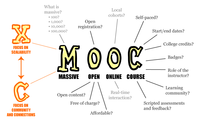
Photo from wikipedia
In large MOOC cohorts, the sheer variance and volume of discussion forum posts can make it difficult for instructors to distinguish nuanced emotion in students, such as engagement levels or… Click to show full abstract
In large MOOC cohorts, the sheer variance and volume of discussion forum posts can make it difficult for instructors to distinguish nuanced emotion in students, such as engagement levels or stress, purely from textual data. Sentiment analysis has been used to build student behavioral models to understand emotion, however, more recent research suggests that separating sentiment and stress into different measures could improve approaches. Detecting stress in a MOOC corpus is challenging as students may use language that does not conform to standard definitions, but new techniques like TensiStrength provide more nuanced measures of stress by considering it as a spectrum. In this work, we introduce an ensemble method that extracts feature categories of engagement, semantics and sentiment from an AdelaideX student dataset. Stacked and voting methods are used to compare performance measures on how accurately these features can predict student grades. The stacked method performed best across all measures, with our Random Forest baseline further demonstrating that negative sentiment and stress had little impact on academic results. As a secondary analysis, we explored whether stress among student posts increased in 2020 compared to 2019 due to COVID-19, but found no significant change. Importantly, our model indicates that there may be a relationship between features, which warrants future research.
Journal Title: IEEE Access
Year Published: 2022
Link to full text (if available)
Share on Social Media: Sign Up to like & get
recommendations!